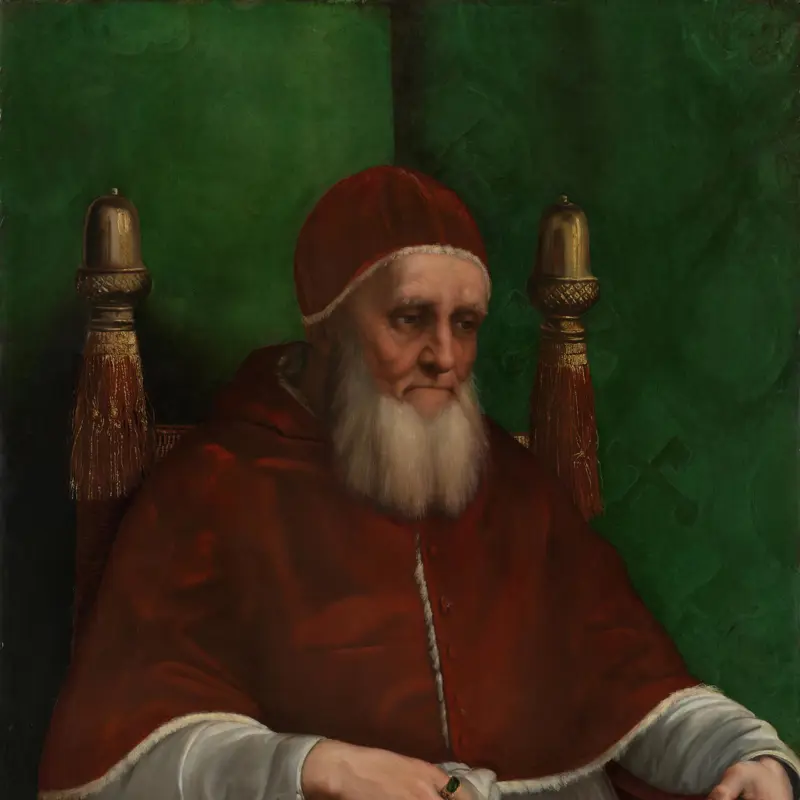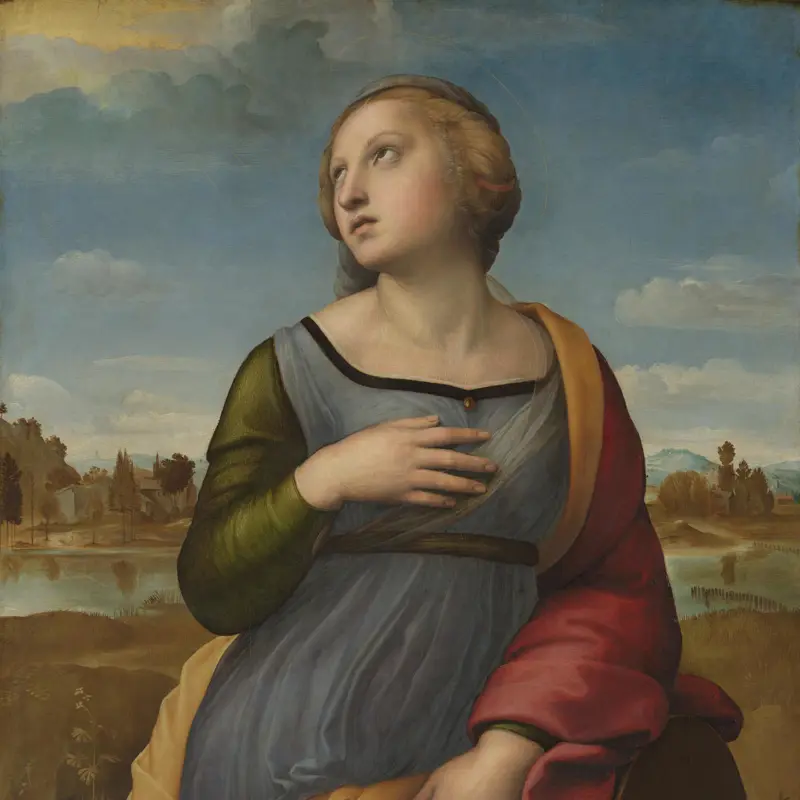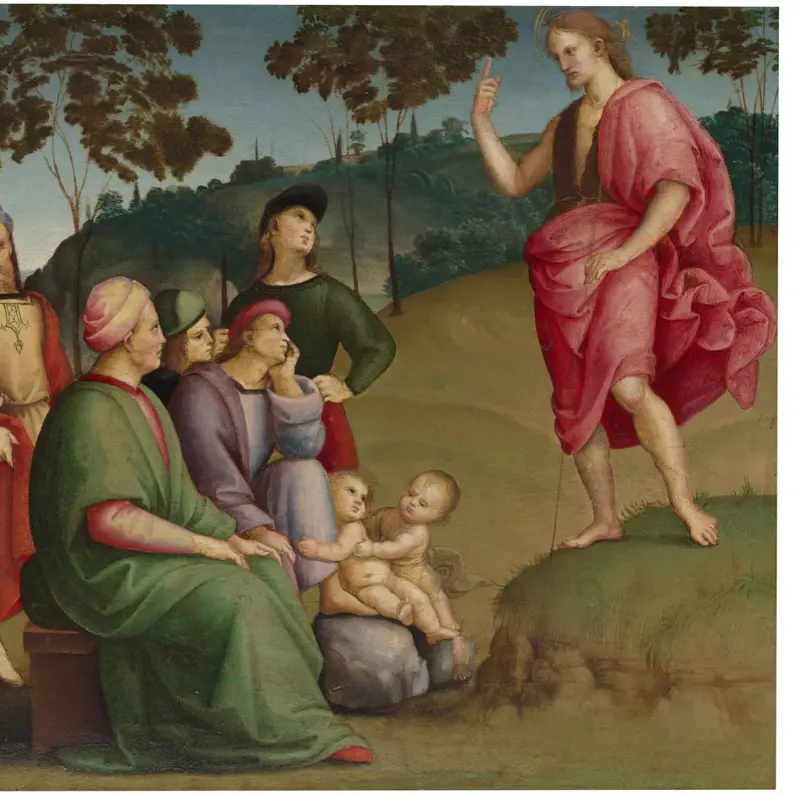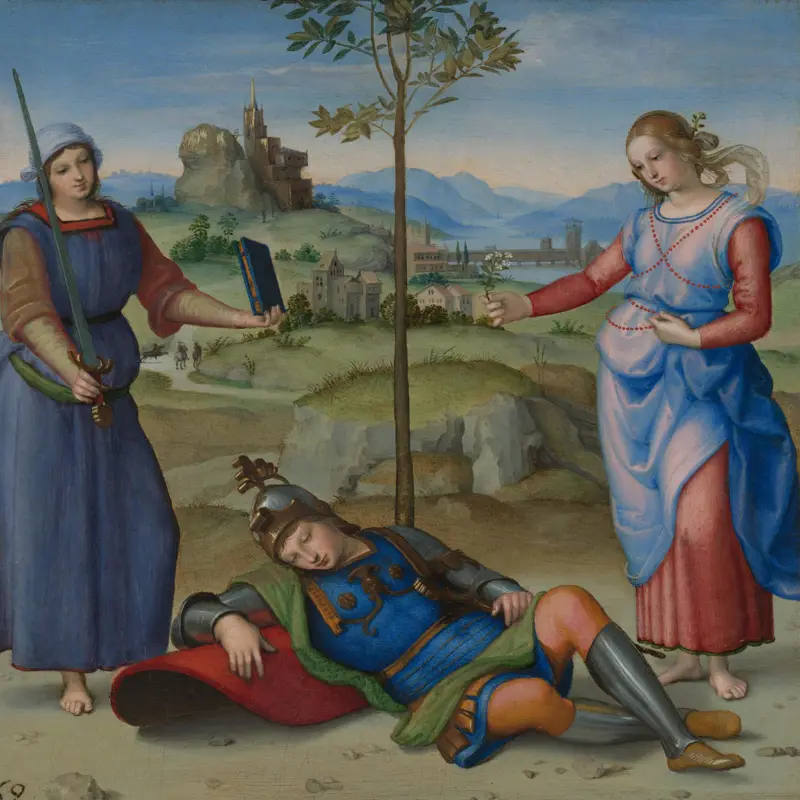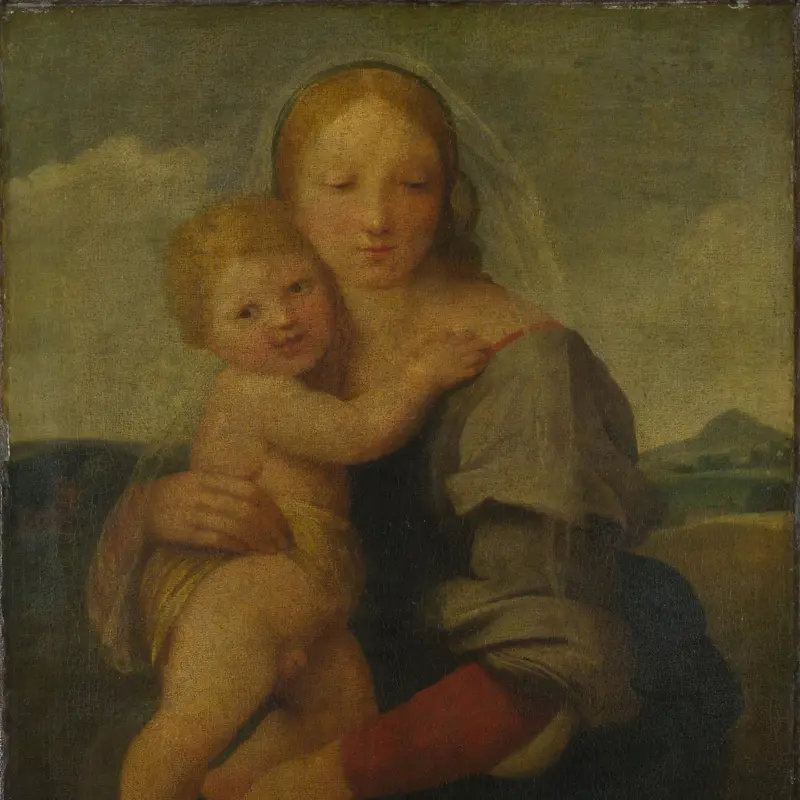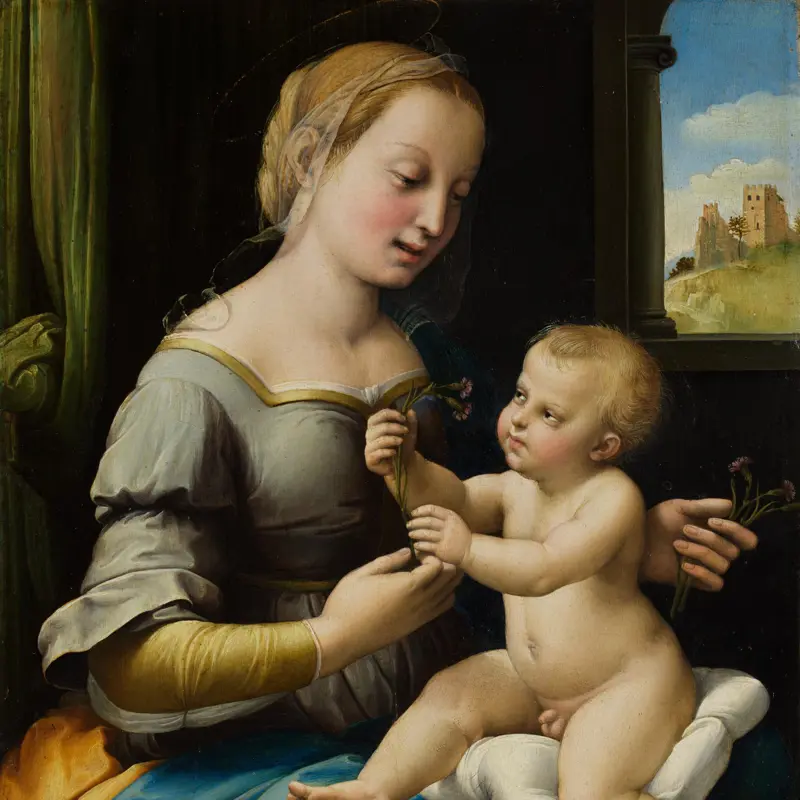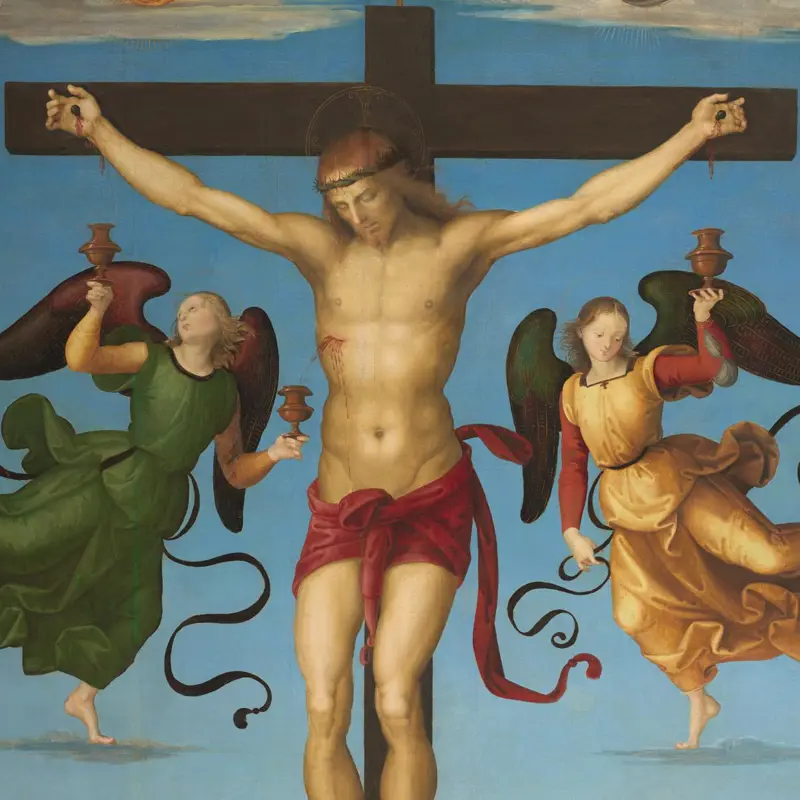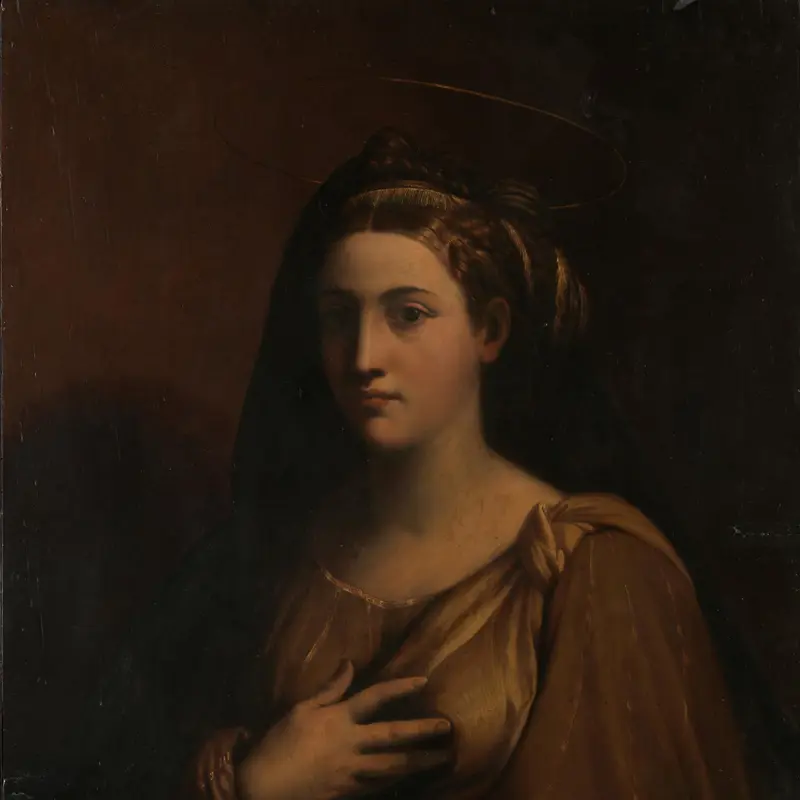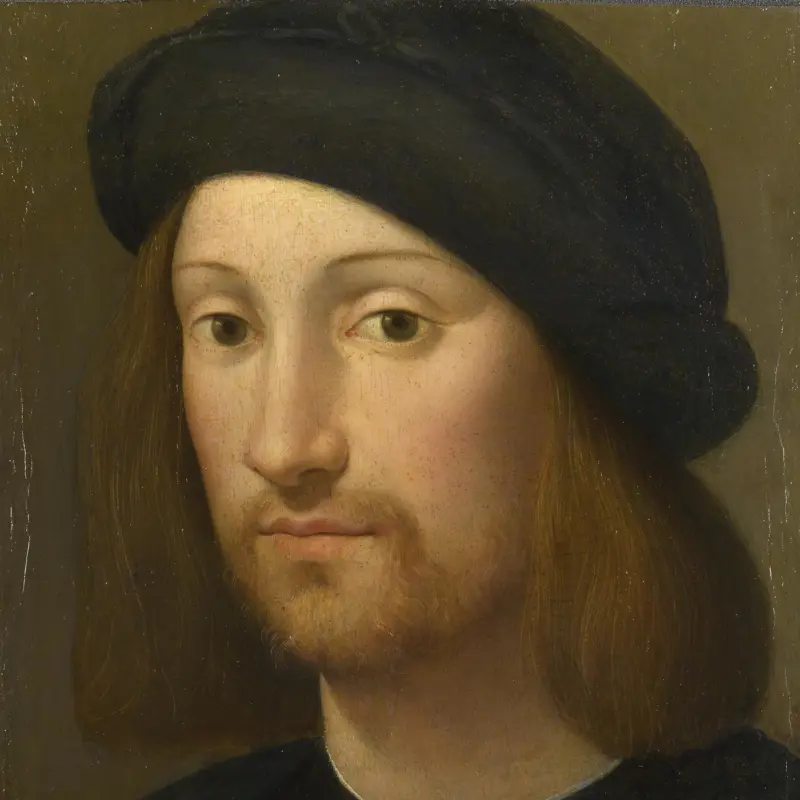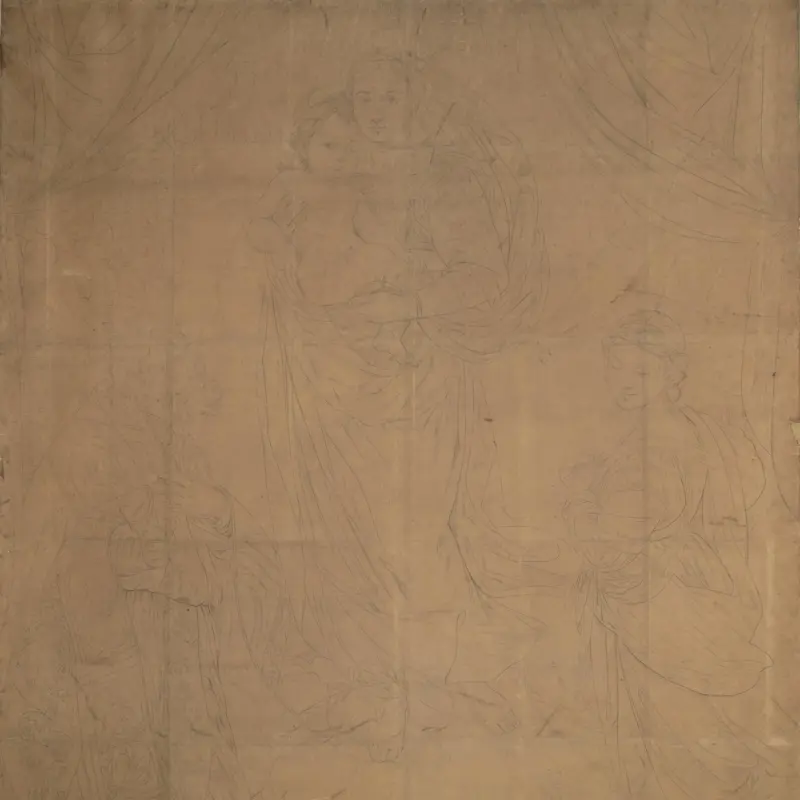Raphael, 'The Garvagh Madonna', about 1510-11
About the work
Overview
In this little picture Raphael depicts the moment when the Christ Child takes a carnation, traditionally symbolic of divine love and the Passion (Christ’s torture and crucifixion), from his cousin John the Baptist’s hand. The space between the children’s hands is the centre of the careful geometry of the composition, emphasising this important moment of Christ’s acceptance of his future sacrifice for humanity. The Virgin appears lost in melancholy thought. Perhaps she is thinking of the children’s destinies.
The picture is one of several small and medium-sized Madonnas that Raphael produced at the same time as he was painting a suite of rooms in the Vatican palace for the pope, the so-called stanze. It was probably made for a member of the papal court for private devotion, although we do not know who commissioned it. The painting is known as the Garvagh Madonna or Aldobrandini Madonna after its previous owner.
Key facts
Details
- Full title
- The Madonna and Child with the Infant Baptist (The Garvagh Madonna)
- Artist
- Raphael
- Artist dates
- 1483 - 1520
- Date made
- about 1510-11
- Medium and support
- oil on wood
- Dimensions
- 38.9 × 32.9 cm
- Acquisition credit
- Bought, 1865
- Inventory number
- NG744
- Location
- Room 7
- Collection
- Main Collection
- Frame
- 20th-century Replica Frame
Provenance
Additional information
Text adapted from the ‘Provenance’ section of the catalogue entry in Carol Plazzotta and Tom Henry, ‘National Gallery Catalogues: The Sixteenth Century Italian Paintings’, vol. 4, ‘Raphael’, London 2022; for further information, see the full catalogue entry.
Exhibition history
-
2012The Sistine Madonna: Raphael's Iconic Painting Turns 500Gemäldegalerie Alte Meister (Dresden)26 May 2012 - 26 August 2012
-
2017Raphael and the Eloquence of DrawingAlbertina26 September 2017 - 7 January 2018
-
2019Raphael and the friends of UrbinoGalleria Nazionale delle Marche3 October 2019 - 19 January 2020
-
2022The Credit Suisse Exhibition: RaphaelThe National Gallery (London)9 April 2022 - 31 July 2022
-
2023Masterpieces from the National GalleryShanghai Art Museum East17 January 2023 - 7 May 2023National Museum of Korea2 June 2023 - 9 October 2023Hong Kong Palace Museum22 November 2023 - 11 April 2024Chimei Museum2 May 2024 - 1 September 2024
-
2024Expérience RaphaelPalais des Beaux-Arts (Lille)18 October 2024 - 17 February 2025
Bibliography
-
1650G. Manilli, Villa Borghese fuori di Porta Pinciana, Rome 1650
-
1787F.W.B. von Ramdohr, Über Mahlerei und Bildhauerarbeit in Rom für Liebhaber des Schönen in der Kunst, Leipzig 1787
-
1824W. Buchanan, Memoirs of Painting: With a Chronological History of the Importation of Pictures by the Great Masters into England Since the French Revolution, London 1824
-
1860J.D. Passavant, Raphaël d'Urbin et son père Giovanni Santi, Paris 1860
-
1882J.A. Crowe and G.B. Cavalcaselle, Raphael: His Life and Works, 2 vols, London 1882
-
1891G. Frizzoni, Arte italiana del Rinascimento, Milan 1891
-
1913O. Fischel, Raphaels Zeichnungen, Berlin 1913
-
1920A. Venturi, Raffaello, Rome 1920
-
1923A. Rosenberg, Raffael, des Meisters Gemälde, in 274 Abbildungen, ed. G. Gronau, Berlin 1923
-
1935A.E. Popham, Catalogue of Drawings in the Collection formed by Sir Thomas Phillipps, Bart., F.R.S., Now in the Possession of His Grandson T. Fitzroy Phillipps Fenwick of Thirlestaine House, Cheltenham, London 1935
-
1936G. Gronau, Documenti artistici urbinati, Florence 1936
-
1938K. Clark, 'The Aesthetics of Restoration', Proceedings of the Royal Institution, XXX/382-403, 1938
-
1939O. Fischel, 'Raphael's Pink Sketch-Book', The Burlington Magazine, LXXIV, 1939, pp. 181-7
-
1948O. Fischel, Raphael, trans. B. Rackham, London 1948
-
1959P. Della Pergola, 'L'inventario del 1592 di Lucrezia d'Este', Arte antica e moderna, VII/2, 1959, pp. 342-51
-
1962Gould, Cecil, National Gallery Catalogues: The Sixteenth Century Italian Schools (excluding the Venetian), London 1962
-
1962E. Camesasca (ed.), Tutta la pittura de Raffaello, 2nd edn, Milan 1962
-
1962P. Pouncey and J. Gere, Italian Drawings in the Department of Prints and Drawings in the British Museum: Raphael and His Circle, London 1962
-
1966P. de Vecchi, L'opera completa di Raffaello, Milan 1966
-
1970J. Pope-Hennessy, Raphael: The Wrightsman Lectures Delivered under the Auspices of the New York Institute of Fine Arts, London 1970
-
1971L. Düssler, Raphael: A Critical Catalogue of His Pictures, Wall-Paintings and Tapestries, trans. S. Cruft, London 1971
-
1975C. Gould, Delaroche and Gautier: Gautier's Views on the 'Execution of Lady Jane Grey' and on other Compositions by Delaroche, London 1975
-
1981A. Brejon de Lavergnée and D. Thiébaut, Italie, Espagne, Allemagne, Grande-Bretagne et divers, Catalogue sommaire illustré des peinture du Musée du Louvre 2, Paris 1981
-
1982P. de Vecchi, Tout l'oeuvre peint de Raphael, Paris 1982
-
1983J.-P. Cuzin, Raphaël: Vie et oeuvre, Fribourg 1983
-
1983P. Joannides, The Drawings of Raphael: With a Complete Catalogue, Oxford 1983
-
1983E. Ullmann, Raffael, Leipzig 1983
-
1984G. Barberini, D. Bernini and S. Stacciolis, Raffaello nelle raccolte Borghese (exh. cat. Museo e Galleria Borghese, January - Mar 1984), Rome 1984
-
1987Gould, Cecil, National Gallery Catalogues: The Sixteenth Century Italian Schools, London 1987
-
1987G. Dalli Regoli, '"Non… da natura, ma per lungo studio": Riferimenti, citazione e rielaborazione nelle Madonne di Raffaello', in M. Sambucco Hamoud and M.L. Strocchi (eds), Studi su Raffaello: Atti del Congresso Internazionale di Studi Urbino and Florence, 6-14 April 1984, Urbino 1987, pp. 419-28
-
1988B. Bohn, 'Bartolommeo Passarotti and Reproductive Etching in Sixteenth-Century Italy', Print Quarterly, V, 1988, pp. 115-27
-
1989S.F. Pagden and M.A. Zancan, Raffaello: Catalogo completo dei dipinti, Florence 1989
-
1990J. Plesters, 'Technical Aspects of some Paintings by Raphael in the National Gallery', in J. Shearman and M.B. Hall (eds), The Princeton Raphael Symposium: Science in the Service of Art History, Princeton 1990, pp. 15-37
-
1992N. Penny, 'Raphael's "Madonna dei Garofani" Rediscovered', The Burlington Magazine, CXXXIV, 1992, pp. 67-81
-
1993J. Dunkerton and N. Penny, 'The Infra-Red Examination of Raphael's "Garvagh Madonna"', National Gallery Technical Bulletin, XIV, 1993, pp. 6-21
-
1994C. Scailliérez, 'Une ébauche de Parmesan (1503-1540), pour le Louvre, un don de la Société des Amis du Louvre', Revue du Louvre, XLIII, 1994, pp. 27-37
-
1995P. de Vecchi, Raffaello: La mimesi, l'armonia e l'invenzione, Florence 1995
-
1999R. Freiherr Hiller von Gaertringen, Raffaels Lernerfahrungen in der Werkstatt Peruginos: Kartonverwendung und Motivübernahme im Wandel, Munich 1999
-
1999K. Oberhuber, Raphael: The Paintings, Munich 1999
-
2001
C. Baker and T. Henry, The National Gallery: Complete Illustrated Catalogue, London 2001
-
2001C. Höper (ed.), Raffael und Die Folgen: Das Kunstwerk in Zeitaltern seiner graphischen Reproduzierbarkeit, Ostfildern-Ruit 2001
-
2002D. Bomford et al., Underdrawings in Renaissance Paintings (exh. cat. The National Gallery, 30 October 2002 - 16 February 2003), London 2002
-
2004A. Roy, M. Spring and C. Plazzotta, 'Raphael's Early Work in the National Gallery: Paintings before Rome', National Gallery Technical Bulletin, XXV, 2004, pp. 4-35
-
2004H. Chapman, T. Henry and C. Plazzotta, Raphael: From Urbino to Rome (exh. cat. The National Gallery, 20 October 2004 - 16 January 2005), London 2004
-
2005J. Meyer zur Capellen, Raphael: A Critical Catalogue of His Paintings, vol. 2, The Roman Religious Paintings, ca. 1508-1520, Landshut 2005
-
2006A. Coliva, Raffaello: Da Firenze a Roma (exh. cat. Museo e Galleria Borghese, 19 May - 27 August 2006), Rome 2006
-
2006G. Finaldi and C. Garridos, El trazo oculto: Dibujos subyacentes en pinturas de los siglos XV y XVI, (exh. cat. Museo Nacional del Prado, 20 July - 5 November 2006), Madrid 2006
-
2022Plazzotta, Carol, and Tom Henry, National Gallery Catalogues: The Sixteenth Century Italian Paintings, 4, Raphael, London 2022
Frame
This is a reproduction frame made in an Italian Renaissance Tuscan style in 1935 by the London-based firm G.P. Coulette. Crafted from walnut, it is partly gilded, with a glazing door skilfully incorporated into the design. The entablature and predella both feature centre rounds and have gilt fillets outlining the square panels. Across the width of the predella is an inscription in gold, detailing the inventory number, artist’s name and date (‘744 MADONNA AND CHILD BY RAPHAEL: 1483–1520’). At the top of the sight edge is a complementary inscription with the acquisition date of the painting (‘PURCHASED 1865’). The frame boasts intricately carved and partly gilt repeat patterns, including a delicate guilloche, egg-and-dart, double bead-and-reel motifs, and dentils, which contrast beautifully with the walnut wood. The two pilasters feature stopped fluting and rosettes in a plain capital.
About this record
If you know more about this work or have spotted an error, please contact us. Please note that exhibition histories are listed from 2009 onwards. Bibliographies may not be complete; more comprehensive information is available in the National Gallery Library.

